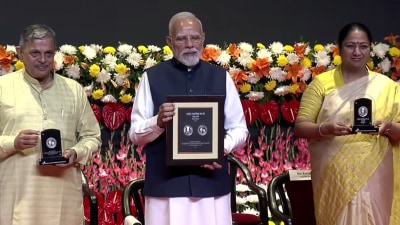Rumsfeld on Gulf footprint mission
US defence Secretary Donald Rumsfeld met United Arab Emirates leaders on Sunday on a tour to thank Gulf allies for help in the Iraq war and ...

US defence Secretary Donald Rumsfeld met United Arab Emirates leaders on Sunday on a tour to thank Gulf allies for help in the Iraq war and discuss a possible new US Military ‘‘footprint’’ in the region.
Rumsfeld landed in Abu Dhabi six hours late after a mechanical problem delayed his aircraft, causing him to miss a planned Sunday visit to Afghanistan. Officials said he hoped to go to Kabul later in the week. US war commander General Tommy Franks flew in from Qatar to take part in the talks with Abu Dhabi Crown Prince Sheikh Khalifa bin Zayed al-Nahayan, UAE Defence Minister Sheikh Mohammed bin Rashid al-Maktoum and the armed forces chief.
‘‘We talked about the way ahead in Iraq and Afghanistan,’’ Rumsfeld told reporters before leaving for Qatar, host to US Military Central Command headquarters. ‘‘We assured the Defence minister and the crown prince that the US intends to do what is necessary with our coalition partners to see that there is a new environment in Iraq, a permissive environment, that allows the Iraqi people to begin that important process of developing an Iraqi interim authority and ultimately a free Iraqi government,’’ he added.
Washington is studying possible changes in its costly military presence in the Middle East, with the removal of Saddam Hussein being seen as potentially allowing a reduction in the US presence in the politically sensitive region.
US defence officials declined to predict whether the UAE, which has ordered 80 advanced US F-16 fighter jets in a deal worth billions of dollars, might benefit from any changes. Asked if they had requested the Emirates to take more US forces in the future in any new realignment, Franks said: ‘‘We didn’t ask the question’’. But he conceded that with the fall of Saddam, Washington was looking closely at realigning its forces in the region. He declined to speculate on whether forces would be smaller. ‘‘We need to see exactly what footprint will have the highest payoff for us,’’ Franks said.
On arriving in the Qatari capital, Doha, Franks commented on the surrender of Saddam’s DyPM, Tariq Aziz, to US forces and said he was providing a lot of information to US intelligence interrogators. He did not elaborate. Rumsfeld said he thanked the oil-rich Emirates for their support in the global war on terror and for help in the Iraq campaign. He said they were also providing major humanitarian aid to Iraq.
Due to security considerations, Pentagon officials gave no advance indication of whether Rumsfeld would visit Iraq itself, where more than 130,000 US troops are now deployed, and would not name other stops on the trip.Rumsfeld told reporters he planned ‘‘to discuss with our allies around Iraq the arrangements that we have with them and our partnership and cooperation as we look forward at some point to the end of major combat activity in Iraq’’.
Military analysts say they expect the US to sharply reduce its military presence in Saudi Arabia, a key ally for decades, and perhaps move some air power from there to Qatar, Oman or the UAE. Washington also has a major military presence in Iraq’s southern neighbour, Kuwait.
US jets have also been using the Prince Sultan Air Base in Saudi Arabia since the end of the Gulf War in 1991 to police a ‘‘no-fly’’ zone over southern Iraq which is no longer needed.
The US Air Force used a sophisticated air war Command Centre at Prince Sultan for the air war against Iraq, but leaders of the conservative kingdom refused to allow attack jets to use the base against Iraqi targets.
Rumsfeld said he would meet Afghan President Hamid Karzai to discuss declaring a formal end to combat operations in most of Afghanistan. (Reuters)



- 01
- 02
- 03
- 04
- 05




























